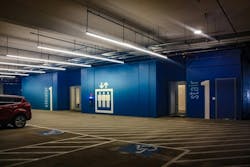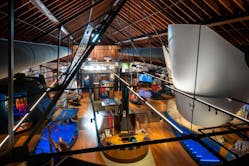Smart lighting controls specialist Casambi announced this morning that North American general manager Mark McClear will succeed Kari Mettälä as CEO of the Helsinki, Finland–based company. After five years leading Casambi, Mettälä will pursue other opportunities.
After leveraging his early experience with semiconductor-based electronics and materials into the LED market with component manufacturers such as Cree LED and Seoul Semiconductor, McClear then dove into finished SSL products at BIOS Lighting before entering the wireless controls space at Casambi in 2022.
“This is an exciting juncture in the lighting industry as luminaires become increasingly smarter. From stamped metal and screw-in lamps, we’ve advanced to integrated LEDs, and it’s now inevitable that all luminaires will soon feature embedded Bluetooth Low Energy radios and sensors,” McClear said in the company’s announcement. “Casambi is poised to lead this transformation as the sole international lighting control platform. Our open ecosystem architecture represents a pioneering leap, surpassing the proprietary legacy systems prevalent in today’s market.”
Yesterday LEDs Magazine spoke with McClear regarding achievements in North America, expanding opportunities for wireless control systems, and prospects for its global operations.
Recent market successes
After nearly a decade of operations in Europe, Casambi invested into its North American expansion in 2021. McClear joined the company as the world was still recovering from pandemic-driven economic challenges. Still, he said, it was an opportune time to plan for growth in a new regional market and reach target expectations.
“In the year that preceded me, we doubled our sales year on year, but from a small base,” McClear explained. “The first year I worked at Casambi, we doubled again. This year, we doubled again! I just put in my business plan for next year, and we’re going to double again.”
He noted that expanding the North American support network for Casambi technology helped greatly with meeting customer expectations alongside sales, without the barrier of a European time difference to access the main Finland-based teams.
Still, Casambi’s wins have stemmed particularly from its ease of programming and reduced hardware investment, according to McClear. “You don’t need hubs, routers, or gateways. You don’t need these [costly] legacy pieces of hardware.… Most users program [the system] themselves. If you already know how to swipe on your iPhone, you already know how to program the system,” he said, citing architectural, hospitality, education, and healthcare projects among the latest adopters of the company’s wireless control ecosystem.
“There’s always the C&I market — such as warehouses, big commercial installations…We’re very good at serving offices, but office space is not doing well right now, except when it is converting from office to residential — which is one market we don’t play much in,” McClear added. But advances such as increased range for the Bluetooth antennas have opened up use cases in outdoor lighting controls, including a recent parking deck project in Texas.
Another trending space for Casambi technology includes historic buildings, which can place unique demands on installers for minimal interference with existing architectural features. One such case is in Newport, Rhode Island, an area known for its distinct Gilded Age historic buildings. “A national sailing museum in Newport […] has these beautiful wood timbers in the ceiling. [The client] wanted lights but they also wanted to make it an event space,” McClear said. “You need one type of light when you’re exhibiting and another when you’re having a cocktail party, for example. So they wanted to be able to use this museum space for event hosting without cluttering the beams and aesthetic with wires. [Casambi technology] was a perfect match for their objectives.”
Control what you can
“While the North American business is taking off and we’ve built a great team here that can take it forward, the European operations are working through an entirely different economic situation,” McClear said. “There is a war going on there, so they’ve got some challenges that I am going to try and lead through.”
Casambi’s Asia regional operation began only a few years before and McClear sees great potential there. “They’re about a year behind North America [in sales and operations]. So they’re going through a lot of the growing pains that I’ve already led through, so I hope to help them solve some of those growth problems [with the Asian market].”
One unusual advantage of Casambi’s controls model, according to McClear, is that supply chain bottlenecks barely made any impact on sales. “We were always at two to four weeks lead time” versus months to a year, he explained, due to the company’s ecosystem architecture. Rather than bundling lights, switches, sensors, and perhaps proprietary drivers into packages for customers — who would need to wait for all of those items to become available for order completion and installation — Casambi and its 200-plus partners offer an open ecosystem, with more than a thousand products currently available and all interoperable.
“We provide the environment for [vendors] to build multiple switches, sensors, and drivers, so that everybody can win. It solves two problems: supply chain management and pricing transparency,” McClear said. Even with multiple switch offerings, customers can assess what options best fit their budgets instead of paying a packaged price for building devices, never knowing what each individual unit costs.
Outside the energy box
Although initiatives to implement new ASHRAE standards around the Pacific Northwest and stricter energy regulations in California Title 24 have increased adoption of luminaire-level lighting controls for the energy savings alone, McClear sees wireless controls driving gains in sustainability and profitability beyond energy.
“If you [retrofit] from a conventional light to LED, you’re going to save roughly 50% on energy [costs.] If you add controls to that, you’re going to save another 20%; to a lot of people, that’s not compelling enough for them,” McClear explained.
A different value proposition emerges when designing controls into a project at the start. “If you design [the control system] as wireless, you eliminate miles of copper wire and hours of installation time. You eliminate junction boxes and conduit. If you’re responsible for a high-end store, do you want to put money into those things up in the ceiling, or do you want to spend that money on a better light fixture that makes your product look better?” McClear asked. “So, in that example, we say to those retail application customers, we can save them 20% on energy, but then we can save an additional 60% on the materials and 60% on the installation costs. They can either keep that or they can [upgrade] their lights. It’s been a much more compelling story.”
CARRIE MEADOWS is editor-in-chief of LEDs Magazine, with 20-plus years’ experience in business-to-business publishing across technology markets including solid-state technology manufacturing, fiberoptic communications, machine vision, lasers and photonics, and LEDs and lighting.
Follow our LinkedIn page for our latest news updates, contributed articles, and commentary, and our Facebook page for events announcements and more. You can also find us on the X platform.
![While Casambi continues to “provide the environment for [vendors] to build multiple switches, sensors, and drivers” to aid in supply chain management and pricing transparency, new CEO Mark McClear also cites big sustainability and money savings potential in reducing wiring, hardware, and installation costs. While Casambi continues to “provide the environment for [vendors] to build multiple switches, sensors, and drivers” to aid in supply chain management and pricing transparency, new CEO Mark McClear also cites big sustainability and money savings potential in reducing wiring, hardware, and installation costs.](https://img.ledsmagazine.com/files/base/ebm/leds/image/2023/11/656662e6b7b187001ecce52f-mark_mcclear_casambi_ceo_comp.png?auto=format,compress&fit=max&q=45&w=250&width=250)







